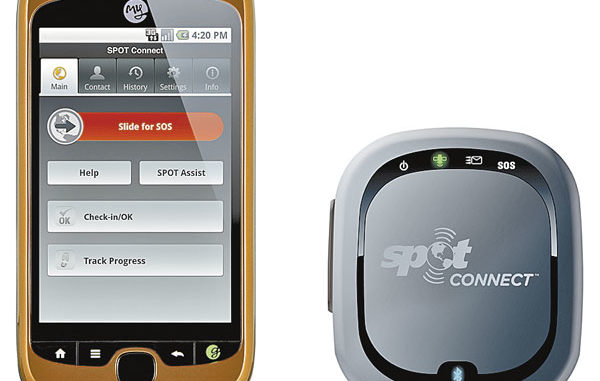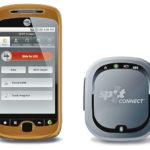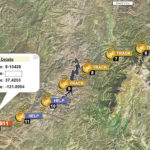
A few issues back, we looked at emergency locator beacons that use the international search and rescue satellite system, and I mentioned that there is another choice, the SPOT satellite GPS messenger. While the EPIRBs and PLBs we looked at before communicate with U.S. and European emergency satellites, SPOT units use the commercial satellite network that supports satellite telephone and Internet communication. And while EPIRBs and PLBs are last-resort devices to be used only in life-threatening emergencies, SPOT can send less-intense transmissions and handle other tasks as well. SPOT also operates on a paid subscription basis, while EPIRBs and PLBs require no subscriptions. Once you buy and activate a SPOT unit, annual subscription plans start at $99.99.
Why SPOT? SPOT’s distress calls are treated just as seriously as those from a PLB or EPIRB, but not all problems are dire emergencies. Let’s say you run out of gas or have engine trouble in your boat in good weather or in your car in a remote area. The cell phone says “no service” and, if you’re in your boat, maybe you can’t reach anyone on your VHF radio. You can hit SPOT’s non-emergency help button, and notify the personal contacts listed on your SPOT account that you need non-emergency assistance.
SPOT acquires your location from its built-in GPS chip, and sends it along with the message every five minutes for one hour, or until you cancel the message. Your contacts receive either a cell phone SMS text message including your coordinates or an email with a link to Google Maps showing your location.
SPOT has also partnered with national service providers and, if you subscribe to SPOT Assist Services, pressing the non-emergency Help button will notify them to help you on land or water.
Perhaps nothing is wrong but you are going to arrive later than scheduled, or haven’t been able to communicate with your registered personal contacts within a prescribed period, and you figure they are getting worried. You can hit SPOT’s Check-in/OK button to send a pre-programmed SMS text or email message to up to 10 pre-determined contacts. Once again, they receive the message and your coordinates or a link to see your position on a Google map.
A Custom Message button activates a feature that sends your contacts any custom message you pre-program. You can use this button as you would the Check-in/OK button to send an “I’m OK” message to friends and family if the Check-in button is already assigned to contact SPOT Assist Services.
A Track Progress button allows you to send and save your location and allow contacts to track your progress in near real time using Google Maps. Once activated, SPOT acquires and sends your GPS coordinates every 10 minutes for 24 hours (or until cancelled) to a SPOT Shared Page you can set up on your account. Share the page’s URL with your friends and family, and they can track the progress of your latest adventure as it unfolds.
Regardless of which feature you use, SPOT acquires your GPS position and then sends it and your message to the commercial satellite system. The system sends the data to the appropriate antenna on the ground where (according to which button you pressed) it is forwarded as an email, a cell phone text message or a distress call to the SPOT Emergency Response Center. The areas of SPOT system coverage center on the major land masses around the globe and surrounding waters. A coverage map and complete information about SPOT can be seen at www.findmespot.com.
Several SPOT products are available. The SPOT Satellite GPS Messenger just described retails for $169.99. A special IS (Intrinsically Safe) version certified to meet the requirements of hazardous work environments retails for $299.99. A smaller SPOT Connect model ($169.99) forms a Bluetooth link with your smartphone (after downloading the SPOT app to the phone), and your phone can then perform all the SPOT tasks when you have no cell-phone signal. You can also type and send 41-character text messages on your phone and update Facebook and Twitter through the satellite system. The somewhat larger original SPOT Personal Tracker ($99.99) is still available, and includes all the regular SPOT features except the Custom Message button.
A new marine SPOT HUG onboard system ($449.99) provides boat theft protection and problem alerts when the boat is docked as well as the regular emergency and non-emergency messaging features while you are out in the boat.
If your boat is moved more than 500 meters without your authority, the unit alerts the Asset Monitoring Center, which then notifies local authorities of the problem and the boat’s position. Connect up to four sensors to HUG, and it will text or email you when a low battery, high water or other monitored condition occurs. It will even send you daily status reports to keep your mind at ease.
SPOT has partnered with DeLorme to combine that company’s hand-held Earthmate PN-60W GPS (street and topo maps included) with a SPOT Satellite Communicator so you can type and send custom text messages via satellite. All the regular SPOT features are included, and you can use the Earthmate’s internal keyboard to create up to 40-character SOS, Help and Check-in/OK messages. You can also send your Check-in/OK messages to social networking sites such as Twitter, Facebook, Geocaching,com and SPOTadventures.com.
When you think about all the money you spend on everything from impulse buys to careful investments, you probably come to the conclusion that sometimes you get your money’s worth and sometimes you don’t. The first time an EPIRB, PLB or SPOT unit saves your life, you won’t have any trouble figuring out into which category its purchase price best fits!




